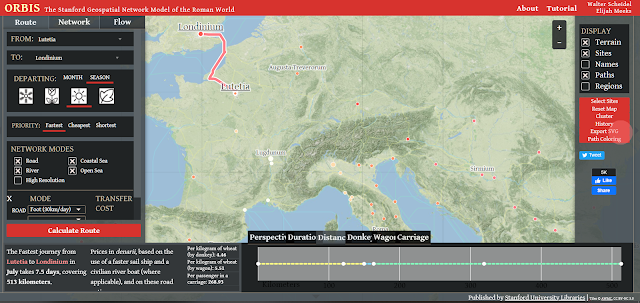We've gotten so used to the convenience of modern travel that it's sometimes hard to appreciate how difficult it was in ancient times.
For example, let's look at travel between London and Paris. If you travel on the Eurostar train, it takes about two hours and fifteen minutes and costs less than $100.
If you lived in the Roman Empire, that trip was a very different proposition.
Take a look at The Stanford Geospatial Network Model of the Roman World, aka ORBIS. Don't be put off the the name; it's an interactive tool that will let you easily answer questions like: "How long would it take to travel between Rome and Paris in the summer?".
It turns out to be 7.5 days. You can also calculate costs, although it will give you the answer in Roman denarii. As near as I can tell, a denarii was roughly a day's wages and the cost of the trip would have been 268 denarii. Assuming a labourer's wage, in today's numbers that would be about $32,000.
ORBIS is easy to use for quick and dirty calculations, but it has many options and is a very powerful tool. From the site's About page:
For the first time, ORBIS allows us to express Roman communication costs in terms of both time and expense. By simulating movement along the principal routes of the Roman road network, the main navigable rivers, and hundreds of sea routes in the Mediterranean, Black Sea and coastal Atlantic, this interactive model reconstructs the duration and financial cost of travel in antiquity.
Taking account of seasonal variation and accommodating a wide range of modes and means of transport, ORBIS reveals the true shape of the Roman world and provides a unique resource for our understanding of premodern history.
Fortunately, there is a tutorial that guides you through the basic settings and their options.
ORBIS could be a lot of fun (and a real timesink) for historians and authors of historical novels. It makes me wonder if it could be (or has been) adapted for other periods and locations. It would be fascinating to see a similar model for Medieval Europe, for example.

No comments:
Post a Comment